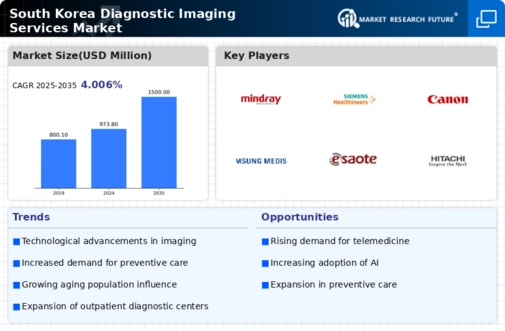Rising Aging Population
The aging population in South Korea is a crucial driver for the diagnostic imaging services market. As individuals age, they often experience a higher incidence of chronic diseases and health complications, necessitating advanced diagnostic imaging services. According to recent statistics, approximately 15% of the population is aged 65 and older, a figure projected to rise significantly in the coming years. This demographic shift is likely to increase the demand for imaging services such as MRI and CT scans, which are essential for accurate diagnosis and treatment planning. Furthermore, the healthcare system is adapting to cater to this demographic, potentially leading to increased investments in imaging technologies and facilities. The growing need for early detection and monitoring of age-related conditions underscores the importance of the diagnostic imaging-services market in addressing the healthcare needs of the elderly population.
Increased Health Awareness
There is a notable rise in health awareness among the South Korean population, which is significantly impacting the diagnostic imaging-services market. As individuals become more informed about health issues and the importance of early detection, the demand for diagnostic imaging services is expected to grow. Surveys indicate that over 60% of South Koreans now prioritize regular health check-ups, including imaging tests, as part of their preventive healthcare routines. This shift in mindset is likely to drive an increase in the utilization of services such as ultrasound and mammography, which are essential for early diagnosis of various conditions. Consequently, healthcare providers are expanding their imaging capabilities to meet this growing demand, thereby enhancing the overall landscape of the diagnostic imaging-services market.
Government Support and Regulation
Government support plays a pivotal role in shaping the diagnostic imaging-services market. In South Korea, the government has implemented various policies aimed at improving healthcare access and quality, which includes enhancing diagnostic imaging services. Recent initiatives have focused on increasing funding for healthcare facilities and promoting the adoption of advanced imaging technologies. For example, the government allocated approximately $500 million for healthcare infrastructure improvements in the last fiscal year, which is expected to bolster the capabilities of diagnostic imaging centers. Additionally, regulatory frameworks are being established to ensure the quality and safety of imaging services, further encouraging investment in this sector. This supportive environment is likely to foster growth in the diagnostic imaging-services market, as providers seek to align with government standards and enhance service offerings.
Rising Incidence of Chronic Diseases
The increasing prevalence of chronic diseases in South Korea is a significant driver for the diagnostic imaging-services market. Conditions such as cardiovascular diseases, diabetes, and cancer are becoming more common, necessitating advanced diagnostic tools for effective management and treatment. Recent health reports indicate that nearly 30% of the adult population is living with at least one chronic condition, a figure that is expected to rise. This trend underscores the need for regular imaging services to monitor disease progression and treatment efficacy. As healthcare providers respond to this growing demand, investments in imaging technologies and services are likely to increase, thereby enhancing the capabilities of the diagnostic imaging-services market. The focus on early detection and ongoing management of chronic diseases will further solidify the market's importance in the South Korean healthcare landscape.
Technological Integration in Healthcare
The integration of advanced technologies into healthcare systems is transforming the diagnostic imaging-services market. Innovations such as artificial intelligence (AI) and machine learning are enhancing the accuracy and efficiency of imaging processes. For instance, AI algorithms can assist radiologists in interpreting images more quickly and accurately, potentially reducing diagnostic errors. In South Korea, the adoption of these technologies is gaining momentum, with a reported increase of 20% in facilities implementing AI-driven imaging solutions over the past year. This trend not only improves patient outcomes but also streamlines workflows, allowing healthcare providers to manage higher patient volumes. As technology continues to evolve, the diagnostic imaging-services market is likely to experience further growth, driven by the demand for more precise and efficient diagnostic tools.




















Leave a Comment